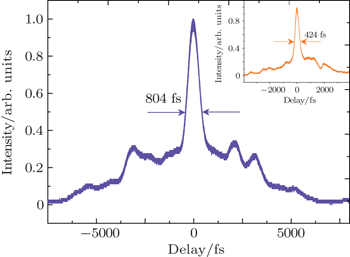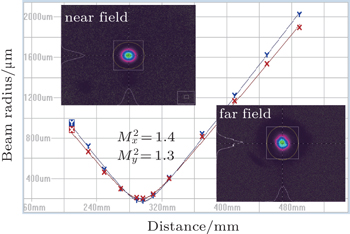† Corresponding author. E-mail:
‡ Corresponding author. E-mail:
Project supported by the National Key Technology Research and Development Program of the Ministry of Science and Technology of China (Grant No. 2012BAC23B03), the National Key Basic Research Program of China (Grant No. 2013CB922401), and the National Natural Science Foundation of China (Grant No. 11474002).
A high-energy femtosecond all ytterbium fiber amplifier based on a chirped-pulse amplification (CPA) technique at a repetition rate of 1 MHz seeded by a dispersion-management mode-locked picosecond broadband oscillator is studied. We find that the compressed pulse duration is dependent on the amplified energy, the pulse duration of 804 fs corresponds to the maximum amplified energy of 10.5 μJ, while the shortest pulse duration of 424 fs corresponds to the amplified energy of 6.75 μJ. The measured energy fluctuation is approximately 0.46% root mean square (RMS) over 2 h. The low-cost femtosecond fiber laser source with super-stability will be widely used in industrial micromachines, medical therapy, and scientific studies.
With the revolutionary advances in gain fibers with large core diameters and high-brightness diode pump sources, the development of fiber lasers has remarkable progress in power scaling,[1,2] pulse shortening,[3] and energy improvement[4,5] in the last decade. Due to the advantages of the excellent optical and gain as well as operation properties, ultrashort pulse fiber lasers have developed rapidly in recent years, which can cater for various applications, such as micromaching, ophthalmology, fluorescence microscopy, and high harmonic generation. Meanwhile, the femtosecond fiber amplifiers with μJ energy level at a repetition rate up to MHz are promising in technique applications because of the higher processing efficiency and precision required in industry and science. In comparison with other types of laser amplifiers based on Ti:Sapphire or rare-earth-doped gain crystals as gain media, scaling of energy of the femtosecond fiber lasers is mainly subjected to the restriction of nonlinear effects, which can degrade the post-compressed pulse quality and duration as a result of the propagation of high peak power laser pulses in the extremely small core. Therefore, the conventional effective route to reduce the peak power of the ultrashort pulse to be amplified is sufficiently scaling in the time domain through the introduction of the chirped-pulse amplification (CPA) technique.
As early as 2007, the 100-μJ high-energy ytterbium-doped fiber CPA amplifier at a 900-kHz repetition rate was reported based on the grating stretcher, where the compressed pulse duration was 500 fs.[6] Additionally, pulse energy with an millijoule level at hundreds of kHz repetition rate with sub-picosecond pulse duration has also been reported using Yb-doped large core photonic crystal fiber[7] in a complicated structure as a result of the coupling of the seed and pump laser into the gain fiber by use of an aspherical and/or spherical focusing lens.[8–11] However, with the increasing requirements for the reliable and stable performance, fiber lasers with a conventional grating stretcher and challenging free space coupling technique cannot satisfy the demand of practical applications due to the instability caused by the grating stretcher and ultraclean maintenance and treatment of fiber ends. Together with the development of the fabrication technique of various fiber-based optical components, the fiber lasers are improved by integration to be robust and have easy operation through advanced fiber fusing splicing technology.[12] As a result, all-fiber integrated ultrashort pulse amplifiers have been widely studied in the past few years.[13–23] With the development and practical requirement as described above, a stable and reliable high-energy femtosecond CPA amplifier at 1 MHz based on an all-fiber scheme is developed in this paper. In this scheme, a piece of single mode fiber with a length of hundreds of meters as the dispersive medium to stretch seed pulses to hundreds of picoseconds is employed, and all the fibers from oscillator to compressor including the pump laser are welded to integration to improve the stability of the laser, except for the grating-pair as an independent compressor. The maximum uncompressed energy of 10.5 μJ with a compressible pulse duration of 804 fs is obtained under a pump power of 18.83 W, which corresponds to the optical conversion efficiency of 55.7%. The shortest pulse width realized in this given setup is 424 fs for amplified uncompressed pulse energy of 6.75 μJ with 13.34-W pump power. The high-energy femtosecond all-fiber amplifier we developed will have wide practical applications in industry, medicine, and science.
The schematic setup of the high-energy femtosecond all-fiber Yb-doped amplifier with an acousto–optic modulator (AOM) as the pulse picker is shown in Fig.
The all-fiber Yb-doped femtosecond CPA amplifier is made up of a fiber stretcher, a single-mode power preamplifier before cutting the pulse train to a repetition rate of 1 MHz, an AOM, two-stage cascade energy amplifiers, and a high power collimator. The amplified output pulses are dispersion compensation in a double-pass transmission grating-pair compressor. Experimentally, in order to keep the preamplifier immunity for the interference from the anti-direction laser, isolators are employed between the adjacent two-stage fiber amplifiers. For the core-pumped power and energy preamplifiers, the pump radiation is provided by 417-mW and 519-mW fiber-coupled diode lasers at a wavelength of 976 nm respectively, and 30-cm-long highly Yb-doped gain fibers are employed to provide the sufficient gain for a small signal amplification. The cladding-pumped energy amplifier employs 1.8-m-long DCF-YDF as the gain medium with a 30-μm core diameter and a 250-μm inner cladding diameter. The wavelength-stabilization pump laser is coupling into the inner cladding of the gain fiber through a multimode combiner in a forward-pumped configuration.
The seed pulses are provided by a broadband dispersion management mode-locked Yb fiber oscillator with 6-ps chirped pulse duration at a 32.75-MHz repetition rate with a spectral bandwidth (FWHM) of 28 nm centered at 1035 nm (Fig.
The preamplified pulses are finally launched into the cladding-pumped energy amplifier to be amplified to high-energy and the spectrum is shown in Fig.
As shown in Fig.
 | Fig. 3. Variations of the amplified uncompressed energy and compressed pulse duration as functions of the pump power in the all-fiber Yb-doped amplifier. |
At 10.5 μJ, the compressed pulse duration is 804 fs via a 1600-lines/mm grating-pair compressor. As shown in Fig.
 | Fig. 5. Measured intensity autocorrelation traces of the compressed pulses at 10.5 μJ and 6.75 μJ (inset), respectively. |
In conclusion, a stable reliable high-energy femtosecond all-fiber monolithic CPA amplifier at a repetition rate of 1 MHz is developed. Pulse energy up to 10.5 μJ has been obtained with 55.7% optical efficiency. The pulses are correspondingly compressed to 804 fs using a pair of transmission grating-pairs and the spectral bandwidth is 12 nm. The shortest pulse duration obtained is 424 fs with an amplified uncompressed pulse energy of 6.75 μJ. On the existing repetition rate basis, the further energy scaling and pulse shortening is possible by optimization and improvement of the stretcher–compressor module and an appropriate fiber length introduced in the final energy amplifier. In addition, with the revolutionary advances in industry, medicine, and science, the requirements for low-cost, reliable, and stable all-fiber ultrafast fiber amplifiers are imminent, so the laser developed in this paper has wide applications in practice.
| 1 | |
| 2 | |
| 3 | |
| 4 | |
| 5 | |
| 6 | |
| 7 | |
| 8 | |
| 9 | |
| 10 | |
| 11 | |
| 12 | |
| 13 | |
| 14 | |
| 15 | |
| 16 | |
| 17 | |
| 18 | |
| 19 | |
| 20 | |
| 21 | |
| 22 | |
| 23 | |
| 24 |






